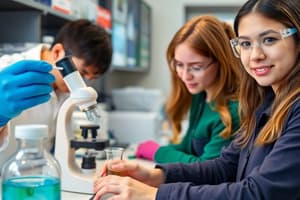Podcast
Questions and Answers
Which laboratory equipment is ideal for precise liquid measurements?
Which laboratory equipment is ideal for precise liquid measurements?
- Boiling Flasks
- Beakers
- Erlenmeyer Flasks
- Graduated Cylinders (correct)
What is the primary use of volumetric flasks?
What is the primary use of volumetric flasks?
- Dispensing liquids dropwise
- Preparing and diluting solutions (correct)
- Heating solutions
- Swirling liquids
How should volumes be read accurately in graduated glassware?
How should volumes be read accurately in graduated glassware?
- At the lowest point of the meniscus (correct)
- At the edge of the liquid surface
- At the midpoint of the meniscus
- At the highest point of the meniscus
What is the function of a burette in laboratory procedures?
What is the function of a burette in laboratory procedures?
Which safety protocol should be used in case of exposure to toxic chemicals?
Which safety protocol should be used in case of exposure to toxic chemicals?
What type of lab equipment is used primarily for heating and swirling liquids?
What type of lab equipment is used primarily for heating and swirling liquids?
Which equipment is used to ensure accurate mass measurement?
Which equipment is used to ensure accurate mass measurement?
What is the main difference between the equivalence point and endpoint in titration?
What is the main difference between the equivalence point and endpoint in titration?
Which equipment is suitable for mixing solutions but not accurate for measuring volumes?
Which equipment is suitable for mixing solutions but not accurate for measuring volumes?
What component adjusts the flame in a Bunsen burner?
What component adjusts the flame in a Bunsen burner?
Flashcards
Test Tubes
Test Tubes
Glass tubes with a rounded bottom and an open top, used to hold small volumes of liquids. Suitable for mixing but not precise volume measurements.
Graduated Cylinders
Graduated Cylinders
Tall, narrow cylinders with markings for accurate measurement of liquid volumes. Preferred over beakers for accuracy, but not as precise as pipettes or burettes.
Beakers
Beakers
Wide-mouthed glass vessels used for heating, mixing, and stirring solutions. Not accurate for measuring specific volumes.
Erlenmeyer Flasks
Erlenmeyer Flasks
Signup and view all the flashcards
Boiling Flasks
Boiling Flasks
Signup and view all the flashcards
Volumetric Flasks
Volumetric Flasks
Signup and view all the flashcards
Droppers
Droppers
Signup and view all the flashcards
Burettes
Burettes
Signup and view all the flashcards
pH Meters
pH Meters
Signup and view all the flashcards
Digital Balances
Digital Balances
Signup and view all the flashcards
Study Notes
Laboratory Equipment and Techniques
-
Test Tubes:
- Glass tubes, one open end, one closed round end.
- Hold small volumes, mix samples.
- Not for measuring volumes.
-
Graduated Cylinders:
- Tall, narrow cylinders with markings.
- Measure liquid volumes.
- Preferred for accuracy over beakers; less accurate than pipettes/burettes.
-
Beakers:
- Wide mouths, used for heating, mixing, stirring solutions.
- Not precise for measuring volumes.
-
Erlenmeyer Flasks:
- Conical shape, narrow neck.
- Safer for mixing and swirling.
- Mix, heat, titrate.
- Not precise for volume measurement.
-
Boiling Flasks:
- Round bottom, long neck.
- Swirl, heat liquids.
- Require clamps for support.
- Not for precise volume measurement.
-
Volumetric Flasks:
- Round base, elongated neck.
- Precise volume measurements.
- Used to prepare/dilute solutions.
- Equipped with caps to prevent evaporation.
-
Droppers:
- Small tubes with rubber bulbs.
- Deliver liquids dropwise.
- Also known as Pasteur pipettes.
-
Burettes:
- Long graduated tubes.
- Precise liquid dispensing.
- Control liquid release with a stopcock.
- Measure volume by initial and final readings.
Bunsen Burners
- Produce open flames.
- Connected to a gas source.
- Adjustable gas flow and airflow.
pH Meters
- Measure solution pH.
- Calibration required before use.
Digital Balances
- Accurately measure mass.
- Use the tare function for accurate measurement.
Pipettes
- Most precise for liquid volume measurement.
- Graduated, volumetric, electronic.
Reading Volumes
- Meniscus: Lowest point in the liquid curve, used to read precise volumes.
Titration
- Known concentration titrant added to unknown solution.
- Equivalence point: Complete reaction occurs.
- Endpoint: Observable change in the solution.
Safety Protocols
- Safety Shower: Emergency for chemical exposure.
- Eye Wash Station: Rinse chemical splashes from eyes
- Fume Hood: Minimize exposure to fumes.
- Fire Extinguishers: Used for solvent/electrical fires.
- Personal Protective Equipment: Lab coats, goggles, gloves, closed-toed shoes.
Significant Digits
- Rules for determining significant digits.
- Non-zero digits are always significant.
- Zeros between non-zero digits are significant.
- Trailing zeros after a decimal point in a number, are significant.
Data & Error Analysis
- Accuracy: Closeness to the true value.
- Precision: Consistency of measurements.
- Systematic Errors: Consistent errors in one direction (faulty equipment).
- Random Errors: Vary each time, often human error.
- Percent Error Formula: % Error = |experimental - actual| / actual * 100%
Studying That Suits You
Use AI to generate personalized quizzes and flashcards to suit your learning preferences.




